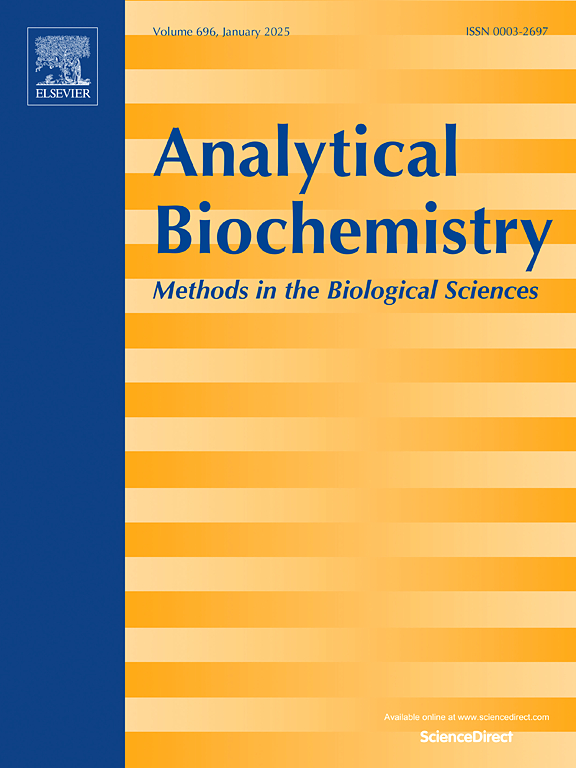Development of a green polymer-based sensor for enhanced iron detection in diverse biological, food and environmental matrices
IF 2.5
4区 生物学
Q2 BIOCHEMICAL RESEARCH METHODS
引用次数: 0
Abstract
The determination of iron in fortified biological and foods samples is mandatory by many global regulatory agencies. A polymer inclusion membrane (PIM) composed of poly (vinyl chloride) (PVC) as the polymer matrix, dioctyl phthalate (DOP) serving as the plasticizer, and methyltrioctyl ammonium chloride (Aliquat 336) acting as the carrier, has proven effective for the preconcentration and analysis of iron. This method utilizes 2-(2-amino-3-hydroxypyridine-4-ylazo) benzoic acid (AHPAB) as a complexing agent, enabling a straightforward colorimetric detection process. Adjusting the chemical and physical factors influencing membrane efficiency expanded its practical applications. The Fe3+ transport remained consistent under the optimum conditions used in fabricating the PIM. Additionally, employing an acetate buffer at pH 3.66 as the stripping phase facilitated efficient Fe3+ transfer, even in the presence of significant competing anions within the analyzed samples. Total iron content was measured after an on-line oxidation process where Fe2+ was converted to Fe3+ using a hydrogen peroxide stream. The Fe2+ concentration was determined by subtracting the Fe3+ value from the total iron concentration. Mass calibration was achieved within the range compatible with ICP-AES. The detection limit, defined as 3σsβ/S, was 1.75 ng/mL. Repeatability, expressed as the relative standard deviation (RSD) from nine measurements at 60 ng/mL, was 1.75 %, while the inter-sensor repeatability across five chelating sensors was 2.5 %. Furthermore, highlight the potential advantages of incorporating AHPAB into PIMs, such as improved stability, reusability, and enhanced selectivity for Fe ions was achieved. The validated PIM-based method was effectively applied to analyze food, biological, and environmental samples containing naturally occurring Fe2+ ions.

一种基于绿色聚合物的传感器,用于在各种生物、食品和环境基质中增强铁的检测。
许多全球监管机构强制要求测定强化生物和食品样品中的铁。以聚氯乙烯(PVC)为聚合物基体,邻苯二甲酸二辛酯(DOP)为增塑剂,甲基三辛基氯化铵(Aliquat 336)为载体组成的聚合物包合膜(PIM)对铁的预富集和分析是有效的。该方法利用2-(2-氨基-3-羟基吡啶-4-基偶氮)苯甲酸(AHPAB)作为络合剂,实现了直接的比色检测过程。调整影响膜效率的化学和物理因素,拓展了膜效率的实际应用。在制备PIM的最佳条件下,Fe3+输运量保持一致。此外,采用pH为3.66的醋酸缓冲液作为溶出相,即使在分析样品中存在大量竞争阴离子的情况下,也能促进Fe3+的有效转移。在使用过氧化氢流将Fe2+转化为Fe3+的在线氧化过程后,测量了总铁含量。Fe2+浓度由总铁浓度减去Fe3+值确定。质量校准在ICP-AES兼容范围内完成。检出限为1.75 ng/mL,定义为3σsβ/S。在60 ng/mL下,9次测量的重复性以相对标准偏差(RSD)表示,重复性为1.75%,而5个螯合传感器的传感器间重复性为2.5%。此外,还强调了将AHPAB掺入pim的潜在优势,如提高稳定性、可重用性和对Fe离子的选择性。验证的基于pim的方法有效地应用于分析含有天然存在的Fe2+离子的食品,生物和环境样品。
本文章由计算机程序翻译,如有差异,请以英文原文为准。
求助全文
约1分钟内获得全文
求助全文
来源期刊

Analytical biochemistry
生物-分析化学
CiteScore
5.70
自引率
0.00%
发文量
283
审稿时长
44 days
期刊介绍:
The journal''s title Analytical Biochemistry: Methods in the Biological Sciences declares its broad scope: methods for the basic biological sciences that include biochemistry, molecular genetics, cell biology, proteomics, immunology, bioinformatics and wherever the frontiers of research take the field.
The emphasis is on methods from the strictly analytical to the more preparative that would include novel approaches to protein purification as well as improvements in cell and organ culture. The actual techniques are equally inclusive ranging from aptamers to zymology.
The journal has been particularly active in:
-Analytical techniques for biological molecules-
Aptamer selection and utilization-
Biosensors-
Chromatography-
Cloning, sequencing and mutagenesis-
Electrochemical methods-
Electrophoresis-
Enzyme characterization methods-
Immunological approaches-
Mass spectrometry of proteins and nucleic acids-
Metabolomics-
Nano level techniques-
Optical spectroscopy in all its forms.
The journal is reluctant to include most drug and strictly clinical studies as there are more suitable publication platforms for these types of papers.
 求助内容:
求助内容: 应助结果提醒方式:
应助结果提醒方式:


